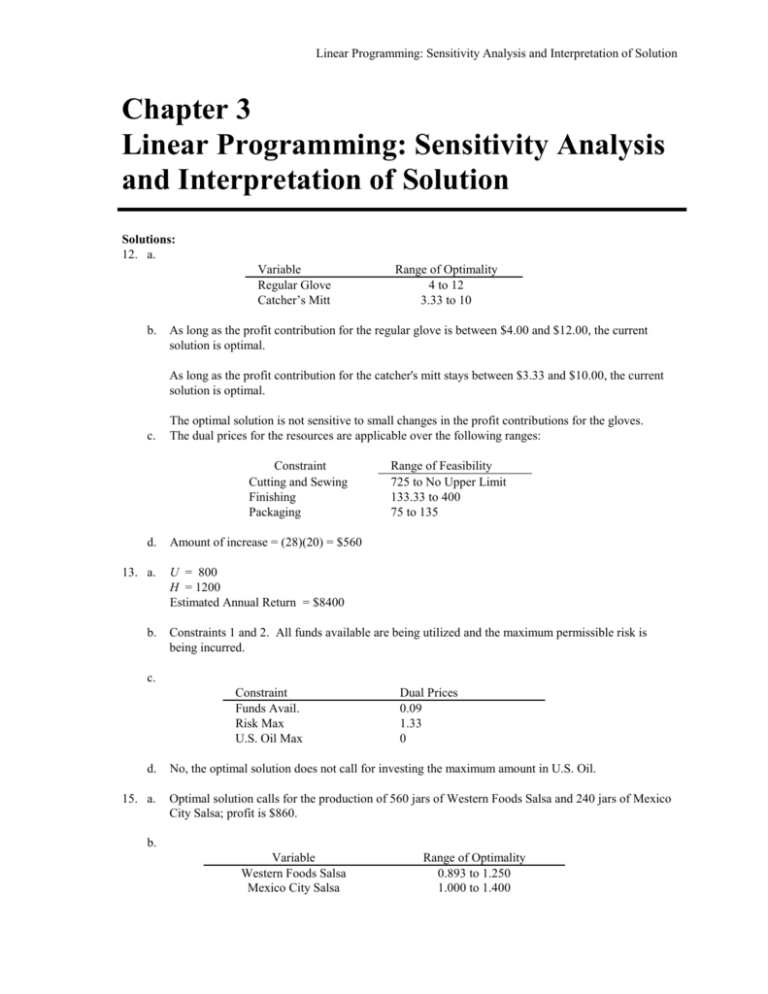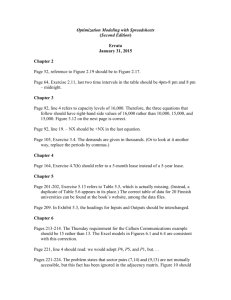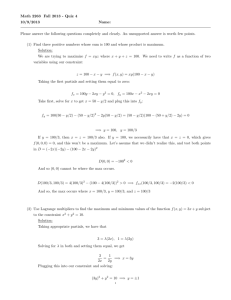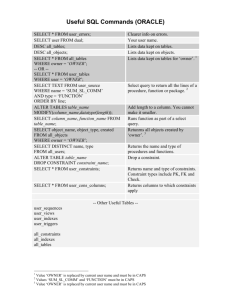Chapter 3
advertisement

Linear Programming: Sensitivity Analysis and Interpretation of Solution Chapter 3 Linear Programming: Sensitivity Analysis and Interpretation of Solution Solutions: 12. a. Variable Regular Glove Catcher’s Mitt b. Range of Optimality 4 to 12 3.33 to 10 As long as the profit contribution for the regular glove is between $4.00 and $12.00, the current solution is optimal. As long as the profit contribution for the catcher's mitt stays between $3.33 and $10.00, the current solution is optimal. c. The optimal solution is not sensitive to small changes in the profit contributions for the gloves. The dual prices for the resources are applicable over the following ranges: Constraint Cutting and Sewing Finishing Packaging d. 13. a. b. Range of Feasibility 725 to No Upper Limit 133.33 to 400 75 to 135 Amount of increase = (28)(20) = $560 U = 800 H = 1200 Estimated Annual Return = $8400 Constraints 1 and 2. All funds available are being utilized and the maximum permissible risk is being incurred. c. Constraint Funds Avail. Risk Max U.S. Oil Max d. 15. a. Dual Prices 0.09 1.33 0 No, the optimal solution does not call for investing the maximum amount in U.S. Oil. Optimal solution calls for the production of 560 jars of Western Foods Salsa and 240 jars of Mexico City Salsa; profit is $860. b. Variable Western Foods Salsa Mexico City Salsa Range of Optimality 0.893 to 1.250 1.000 to 1.400 Chapter 3 c. Constraint 1 Dual Price 0.125 2 0.000 3 0.187 Interpretation One more ounce of whole tomatoes will increase profits by $0.125 Additional ounces of tomato sauce will not improve profits; slack of 160 ounces. One more ounce of tomato paste will increase profits by $0.187 d. Constraint 1 2 3 17. a. Range of Feasibility 4320 to 5600 1920 to No Upper Limit 1280 to 1640 No change in optimal solution; there is no upper limit for the range of optimality for the objective coefficient for S. b. No change in the optimal solution; the objective coefficient for M can increase to 6.4. c. There is no upper limit on the allowable increase for CS ; thus the percentage increase is 0%. For C M , we obtain 0.3/3.4 = 0.088 The accumulated percentage change is 8.8%. Thus, the 100% rule is satisfied and the optimal solution will not change. 18. a. E = 80, S = 120, D = 0 Profit = $16,440 b. Fan motors and cooling coils c. Labor hours; 320 hours available. d. Objective function coefficient range of optimality No lower limit to 159. Since $150 is in this range, the optimal solution would not change. 19. a. Range of optimality E S D 47.5 to 75 87 to 126 No lower limit to 159. b. Model E S D Profit $63 $95 $135 Change Increase $6 Decrease $2 Increase $4 Allowable Increase/Decrease $75 - $63 = $12 $95 - $87 = $8 $159 - $135 = $24 % 6/12 = 0.50 2/8 = 0.25 4/24 = 0.17 0.92 Linear Programming: Sensitivity Analysis and Interpretation of Solution Since changes are 92% of allowable changes, the optimal solution of E = 80, S = 120, D = 0 will not change. However, the change in total profit will be: E 80 unit @ + $6 = S 120 unit @ - $2 = $480 -240 $240 Profit = $16,440 + 240 = 16,680. c. Range of feasibility Constraint 1 Constraint 2 Constraint 3 d. 160 to 180 200 to 400 2080 to No Upper Limit Yes, fan motors = 200 + 100 = 300 is outside the range of feasibility. The dual price will change. 20. a. b. Manufacture 100 cases of model A Manufacture 60 cases of model B Purchase 90 cases of model B Total Cost = $2170 Demand for model A Demand for model B Assembly time c. Constraint 1 2 3 4 Dual Price -12.25 -9.0 0 .375 If demand for model A increases by 1 unit, total cost will increase by $12.25 If demand for model B increases by 1 unit, total cost will increase by $9.00 If an additional minute of assembly time is available, total cost will decrease by $.375 d. The assembly time constraint. Each additional minute of assembly time will decrease costs by $.375. Note that this will be true up to a value of 1133.33 hours. Some students may say that the demand constraint for model A should be selected because decreasing the demand by one unit will decrease cost by $12.25. But, carrying this argument to the extreme would argue for a demand of 0. 21. a. Decision Variable AM BM AP BP Ranges of Optimality No lower limit to 11.75 3.667 to 9 12.25 to No Upper Limit 6 to 11.333 Chapter 3 b. Provided a single change of an objective function coefficient is within its above range, the optimal solution AM = 100, BM = 60, AP = 0, and BP = 90 will not change. This change is within the range of optimality. The optimal solution remains AM = 100, BM = 60, AP = 0, and BP = 90. The $11.20 - $10.00 = $1.20 per unit cost increase will increase the total cost to $2170 = $1.20(100) = $2290. c. Variable AM BM Cost 10 6 Change Increase 1.20 Decrease 1 Allowable Increase/Decrease 11.75 - 10 = 1.75 6.0 - 3.667 = 2.333 Percentage Change (1.20/1.75)100 = 68.57 (1/2.333)100 = 42.86 111.43 111.43% exceeds 100%; therefore, we must resolve the problem. Resolving the problem provides the new optimal solution: AM = 0, BM = 135, AP = 100, and BP = 15; the total cost is $22,100. 22. a. All Pro: 1000 College: 200 High School: 0 b. The sewing constraint and the minimum production requirement for the All Pro model. c. Constraint 1: There are 4000 minutes of unused cutting and dyeing time. Constraint 2: All the sewing time is being utilized at the optimal solution. Constraint 3: There are 5200 minutes of unused inspection and packaging time. Constraint 4: Only the minimum number of All-Pro models is being produced. d. Variable A C H Range of Optimality No Lower Limit to 5 5 to No Upper Limit No Lower Limit to 4 No amount of decrease in the profit contribution for the All Pro and High School models will cause the optimal solution to change. A small decrease in the profit contribution for the College model will cause the optimal solution to change. A small increase in the profit contribution for the High School model will cause a change in the optimal solution. 24. a. b. Let H = amount allocated to home loans P = amount allocated to personal loans A = amount allocated to automobile loans Max 0.07H + 0.12P + 0.09A s.t. H + P + A = 1,000,000 0.6H 0.4P 0.4A 0 P 0.6A 0 H = $400,000 P = $225,000 A = $375,000 Total annual return = $88,750 Amount of New Funds Minimum Home Loans Personal Loan Requirement Linear Programming: Sensitivity Analysis and Interpretation of Solution Annual percentage return = 8.875% c. The range of optimality for H is No Lower Limit to 0.101. Since 0.09 is within the range of optimality, the solution obtained in part (b) will not change. d. The dual price for constraint 1 is 0.089. The range of feasibility for constraint 1 is 0 to No Upper Limit. Therefore, increasing the amount of new funds available by $10,000 will increase the total annual return by 0.089 (10,000) = $890. e. The second constraint now becomes -0.61H - 0.39P - 0.39A 0 The new optimal solution is H = $390,000 P = $228,750 A = $381,250 Total annual return = $89,062.50, an increase of $312.50 Annual percentage return = 8.906%, an increase of approximately 0.031%. 29. a. Let O1 O2 O3 C1 C2 C3 = = = = = = percentage of Oak cabinets assigned to cabinetmaker 1 percentage of Oak cabinets assigned to cabinetmaker 2 percentage of Oak cabinets assigned to cabinetmaker 3 percentage of Cherry cabinets assigned to cabinetmaker 1 percentage of Cherry cabinets assigned to cabinetmaker 2 percentage of Cherry cabinets assigned to cabinetmaker 3 Min 1800 O1 + 1764 O2 + 1650 O3 + 2160 C1 + 2016 C2 + 1925 C3 s.t. 50 O1 + 60 C1 42O2 + 48 C2 30 O3 + 35 C3 O1 + O2 + O3 C1 + C2 + C3 O1, O2, O3, C1, C2, C3 0 = = 40 30 35 1 1 Hours avail. 1 Hours avail. 2 Hours avail. 3 Oak Cherry Note: objective function coefficients are obtained by multiplying the hours required to complete all the oak or cherry cabinets times the corresponding cost per hour. For example, 1800 for O1 is the product of 50 and 36, 1764 for O2 is the product of 42 and 42 and so on. b. Oak Cherry c. d. e. Cabinetmaker 1 O1 = 0.271 C1 = 0.000 Cabinetmaker 2 O2 = 0.000 C2 = 0.625 Cabinetmaker 3 O3 = 0.729 C3 = 0.375 Total Cost = $3672.50 No, since cabinetmaker 1 has a slack of 26.458 hours. Alternatively, since the dual price for constraint 1 is 0, increasing the right hand side of constraint 1 will not change the value of the optimal solution. The dual price for constraint 2 is 1.750. The upper limit on the range of feasibility is 41.143. Therefore, each additional hour of time for cabinetmaker 2 will reduce total cost by $1.75 per hour, up to a maximum of 41.143 hours. The new objective function coefficients for O2 and C2 are 42(38) = 1596 and 48(38) = 1824, respectively. The optimal solution does not change but the total cost decreases to $3552.50.









